Research
Focus 1:
Morpho- and sediment dynamics in coastal waters
The dynamics of ebb deltas, barrier islands, tidal flats, sea tidal flats, the coastline as a whole or important economic shipping routes within the German Bight and its estuaries are essentially determined by the natural interaction of tides, swell and coastal currents. With the help of complex numerical models, the morphodynamic movements of the bottom sediments can be simulated and predicted. This makes it possible, for example, to make long-term predictions about the sediment budget of a tidal basin.
| Overview of the dynamics of the suspended sediment load under the influence of swell off the barrier islands and tidal currents. Strong winds from the northwest can still lead to a loss of sediment across the eastern boundary of the tidal basins. | 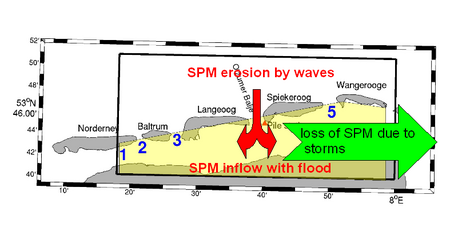 |
Focus 2:
Simulation of pollutant discharges in coastal waters
The discharge of wastewater into water bodies represents an intervention in the marine ecosystem. The properties of seawater can be altered by discharges of substances that have a composition different from that of the water itself. The extent of the impact is often unclear in advance, which is why forecasting methods are used to estimate possible developments. For this purpose, the simulation of dispersion processes in the ocean has become increasingly important, especially in recent years.
Example: Discharge of nutrient-rich precipitation water into the Jade Bay
The task of this work was to find out by modelling how wastewater polluted with various substances behaves and spreads after discharge from point sources into the Jade Bay. It is examined how nutrient-enriched rainwater, which is to be discharged into the Jade Bay through a newly planned drainage system, affects the prevailing salinity and the naturally existing concentration ratios of total nitrogen. Since the continuous dyke line around the Jade Bay makes natural drainage impossible, inland drainage into the sea has become the main task of water management. There is also the question of how marine animals and plants can cope with a reduction in salinity due to freshwater inflow.
| Simulation of the dispersion of nutrient-rich wastewater from agriculture in the Jade Bay after 5 days at high tide (left) and low tide (right). | 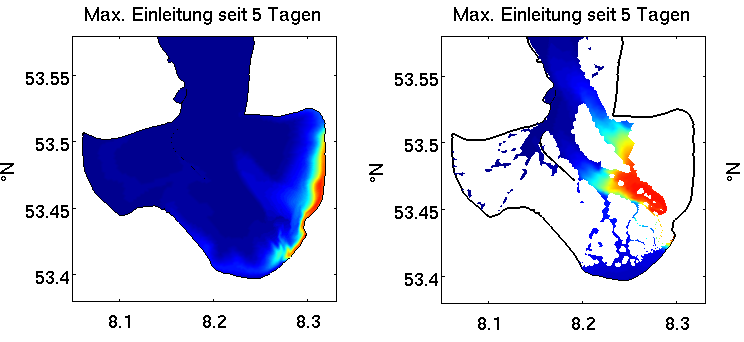 |
Example: Discharge of cooling water from coal-fired power plants into the Inner Jade
In the course of this work, we simulated the discharge of cooling water from coal-fired power plants at the Wilhelmshaven site into the Inner Jade. This topic is currently very topical and of great importance, since another coal-fired power plant is under construction next to the E.ON coal-fired power plant that has been in operation since 1975. The energy company GDF SUEZ1 intends to complete this in Rüstersieler Groden, north of the E.ON power plant, by the end of 2013. The development plan of the city of Wilhelmshaven allows the site to potentially support a total of four coal-fired power plants. The possibility of withdrawing cooling water from the Inner Jade and also returning it to it makes this site very attractive for power plants with freshwater cooling. Unlike taking cooling water from a river, it is assumed that the larger water reservoir and the strong tidal currents mean that the injected cooling water is well distributed and the Jade only warms up insignificantly.
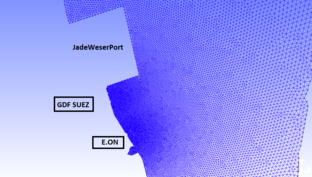 | Left: The unstructured grid in the area of the potential discharge points. |
| Right: Simulated temperature increase in the Jade Bay during the flood phase. | 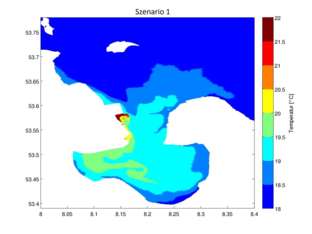 |
Focus 3:
Wave-current interaction
Especially in shallow coastal waters, there is a complex interaction between currents driven by wind or tides and wind-generated surface gravity waves (also called swell). For example, wave trains increase when they run against a current.
Of particular interest with regard to sediment redistribution are currents set in motion by waves when they lose their energy in shallow beach areas (e.g. by breaking). This is how e.g. the longshore currents or so-called 'rip currents' develop, which can be especially dangerous for swimmers, as they are directed away from the beach into deep water.
| The upper image shows wave-induced shore-parallel currents simulated with FVCOM for a constant easterly wind. The lower one for a constant westerly wind of the same strength, which leads to smaller waves on the East Frisian coast. | 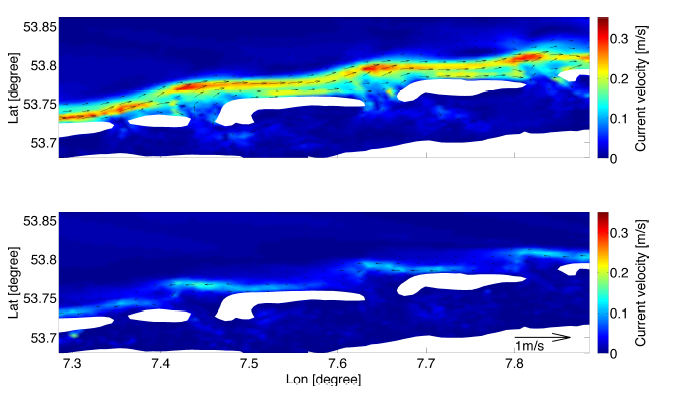 |



![[Translate to English:]](/f/5/_processed_/3/2/csm_ICBM-Logo-transparent-_91fe1c6774.png)